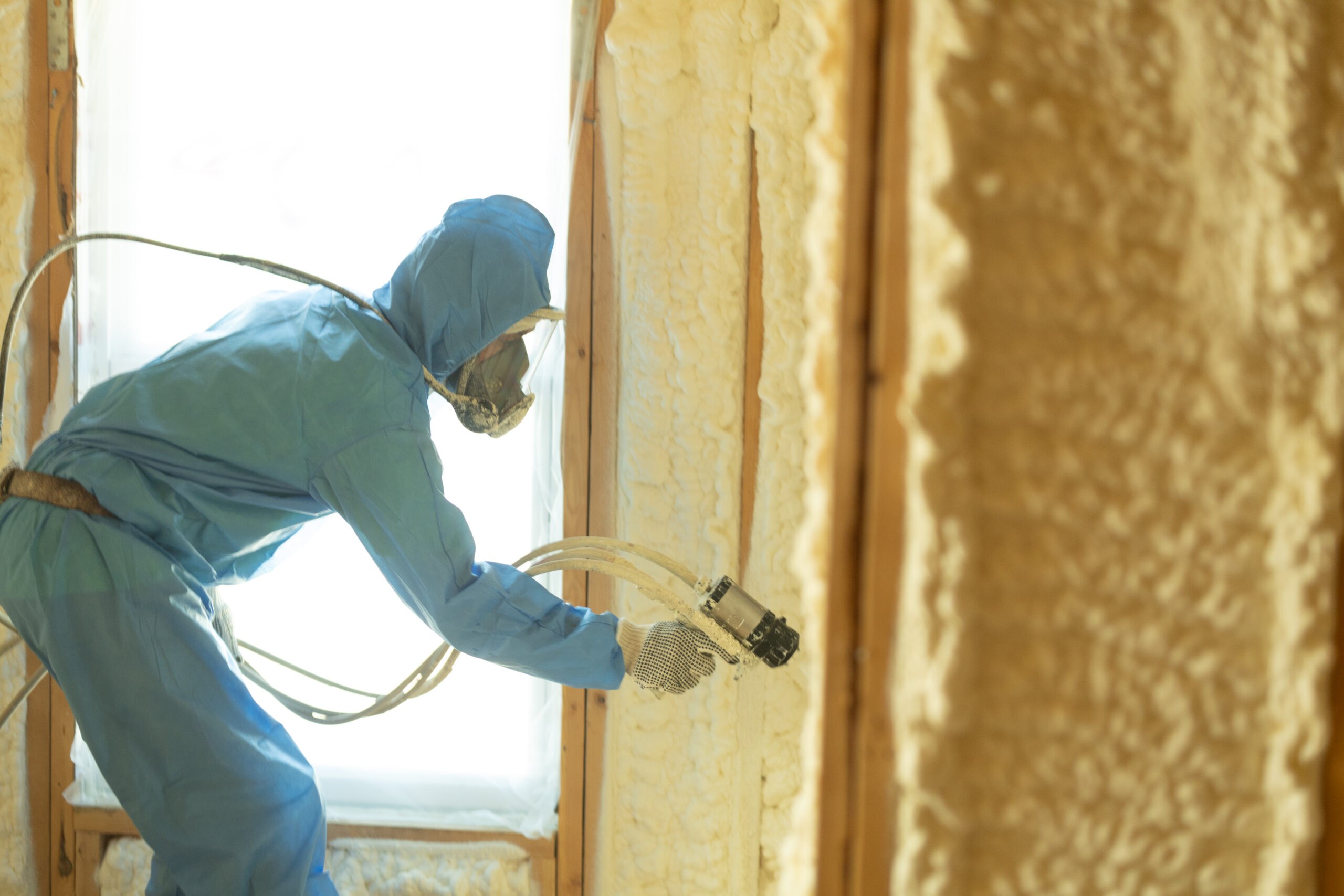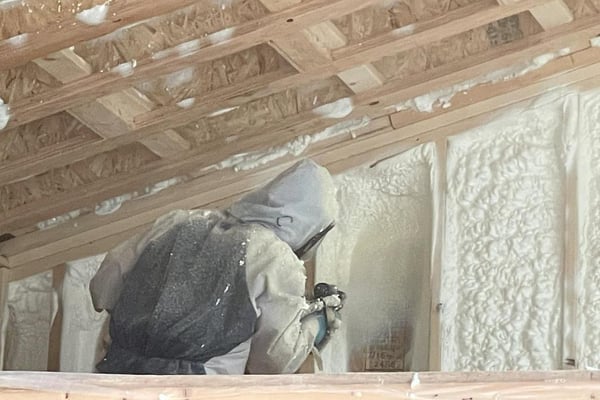How Spray Foam Can Boost Power Effectiveness in Your Home
Spray Foam: The Ultimate Solution for Air Sealing and Insulation
Spray foam insulation has actually become a leading remedy for effective air sealing and thermal insulation, supplying a special combination of homes that set it aside from typical methods. Its capability to increase and fill voids makes it specifically efficient in stopping air leakage, which can substantially influence power efficiency. Recognizing the complete scope of its benefits, setup procedures, and contrasts with other insulation types is essential for making notified decisions. As we check out these elements, the ramifications for both new buildings and retrofits end up being progressively substantial. What variables should affect your option?
What Is Spray Foam?
Spray foam is a functional insulation product that integrates the principles of air securing and thermal resistance to improve energy efficiency in structures. Composed primarily of polyurethane or various other similar compounds, spray foam is used as a liquid that expands upon call with surfaces, creating a strong, continuous layer of insulation. This unique residential or commercial property allows it to load spaces, fractures, and voids that traditional insulation products may forget, supplying a remarkable air seal.
There are two major kinds of spray foam: open-cell and closed-cell. Open-cell spray foam is lighter and more adaptable, supplying superb noise absorption and a reduced R-value per inch - Spray Foam. On the other hand, closed-cell spray foam is denser, providing a higher R-value, moisture resistance, and included architectural stability to constructing elements
The application procedure typically involves specialized devices, guaranteeing a smooth application that abides by numerous substrates, including concrete, timber, and steel. This adaptability makes spray foam appropriate for both brand-new buildings and retrofitting existing frameworks. Its ability to produce an airtight obstacle considerably adds to reducing energy intake and enhancing interior air top quality, thereby making it a favored option amongst homeowners and contractors alike.
Advantages of Spray Foam Insulation
Among one of the most significant advantages of spray foam insulation is its phenomenal capability to develop a continuous air barrier, which efficiently decreases energy loss. Unlike standard insulation products, spray foam broadens to fill up voids and splits, ensuring that air leakage is substantially lowered. This particular not just enhances energy effectiveness yet also results in lower utility bills with time.
In addition, spray foam insulation offers exceptional thermal resistance, contributing to a more stable interior setting. Its high R-value per inch permits efficient insulation in restricted areas, making it optimal for attics, walls, and crawl rooms. Furthermore, the moisture-resistant buildings of spray foam aid protect against mold and mildew and mold growth, promoting much healthier living problems.
An additional essential benefit of spray foam insulation is its sound-dampening qualities (Spray Foam). It properly minimizes noise transmission in between spaces, developing a quieter and much more comfortable home setting. The toughness of spray foam also attracts attention, as it does not droop or clear up over time, keeping its efficiency throughout its lifespan
Just How Spray Foam Works
Recognizing how spray foam insulation functions is crucial for appreciating its effectiveness in air securing and thermal resistance. Spray read foam insulation includes 2 main parts: isocyanate and polyol resin. When these parts are blended, they undertake a chemical reaction that creates the material to broaden rapidly, developing a dense foam that fills up tooth cavities, splits, and voids.
As the foam broadens, it follows surface areas, developing an airtight seal that dramatically minimizes air infiltration. This characteristic makes spray foam insulation very reliable at stopping drafts and wetness penetration, which can cause power loss and damages gradually. Furthermore, the closed-cell variation of spray foam provides superior thermal resistance as a result of its rigid structure, successfully decreasing warmth transfer.
The special properties of spray foam allow it to adhere to uneven surface areas, making certain comprehensive insurance coverage and a seamless barrier. Therefore, spray foam insulation not only enhances energy efficiency but also contributes to improved interior air top quality by lowering the buildup of toxins and irritants. Inevitably, comprehending the auto mechanics behind spray foam highlights its function as a premium choice for insulation and air securing in both household and business applications.
Installation Process Review

Prior to installment, the room needs to be sufficiently cleaned and prepped, guaranteeing that surface areas are without moisture, dust, and particles. This step is critical because pollutants can endanger attachment and overall efficiency. When the location is prepared, the application involves mixing both elements of the spray foam, which expands upon contact and fills up voids properly.
Educated professionals ought to carry out the setup, using customized tools to ensure uniform coverage and ideal thickness. Safety and security precautions, including wearing protective gear and ensuring proper ventilation, are essential during this procedure. After application, the foam typically treatments quickly, forming a strong obstacle that boosts energy effectiveness.
Contrasting Spray Foam to Typical Insulation
When assessing insulation options, spray foam insulation sticks out in comparison to standard materials such as fiberglass and cellulose. Among the key benefits of spray foam is its exceptional air sealing capacities. Unlike fiberglass and cellulose, which can enable air infiltration, spray foam expands upon application, filling up crevices and gaps to create an impermeable seal. This leads to boosted power performance, as less warmed or cooled air escapes the home, resulting in lower energy expenses.
Additionally, spray foam gives a higher R-value per inch than typical insulation types, supplying more reliable thermal resistance in a thinner profile. This particular is particularly advantageous in rooms with restricted cavity deepness. Additionally, spray foam is immune to moisture and mold growth, which can be a considerable concern with cellulose and fiberglass, specifically in damp environments.
Nevertheless, spray foam insulation normally lugs a higher in advance price than its traditional equivalents. Homeowners need to weigh this preliminary financial investment versus long-lasting energy cost savings and efficiency benefits. their website Inevitably, while both insulation types offer their function, spray foam becomes an advanced remedy for modern insulation requirements, specifically in terms of air securing and thermal effectiveness.

Verdict
In summary, spray foam insulation represents an extremely effective service for accomplishing optimum air securing and thermal resistance. Its special residential or commercial properties, including wetness resistance and noise dampening, make it appropriate for different applications in both new constructions and retrofitting projects (Spray Foam). The preliminary expenses may be higher compared to conventional insulation materials, the long-term benefits, such as significant power financial savings and improved indoor air high quality, justify the financial investment and emphasize its worth in contemporary building methods.
Spray foam insulation has actually arised as a leading option for efficient air securing and thermal insulation, using a special combination of properties that set it apart from conventional methods.Spray foam is a versatile insulation product that integrates the principles of air securing and thermal resistance to boost power effectiveness in buildings.When evaluating insulation alternatives, spray foam insulation stands out in contrast to standard products such as fiberglass and cellulose. Eventually, while both insulation types serve their objective, spray foam emerges as a more advanced remedy for modern-day insulation needs, particularly in terms of air securing and thermal effectiveness.
In recap, spray foam insulation stands for a highly reliable option for achieving optimum air securing and thermal resistance.